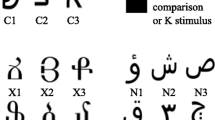Abstract
Two experiments were conducted to investigate the relationship between nodal distance, response accuracy, and response latency during testing for emergent relations. In both experiments, undergraduate subjects first learned A-B, B-C, C-D, and D-E constituent relations of six 5-member equivalence classes. In Experiment 1, only selected tests of trained and of 0-, 1-, and 2-node tests of emergent relations were carried out in order to avoid testing of 0- or 1-node relations that might form constituents of the 2-node relations which were tested. In Experiment 2, all possible trained and derived relations were tested in random order. Although considerable individual variability was observed in both response times and accuracy for the 14 subjects completing Experiment 1, latencies for correct responses generally increased and response accuracy decreased as a function of nodal distance. There was no nodal distance effect for latencies of incorrect responses. In Experiment 2, these relationships between response times, response accuracy, and nodal distance were observed for 3-node relations in 5 out of 6 subjects. Analysis of error response latencies for 2 subjects who made sufficient errors revealed a nodal distance effect for 1 subject but not for the other. In both experiments, response times decreased as testing progressed, but response accuracy increased during testing only in the second experiment.
Similar content being viewed by others
References
ANDERSON, J. R. (1985). The architecture of cognition. New York: W. H. Freeman.
BENTALL, R. P., & DICKINS, D. W. (1994). Differences between animal and human learning: Implicit and explicit processes. In N. C. Ellis (Ed.), Implicit and explicit learning of languages. London: Academic Press.
BENTALL, R. P., DICKINS, D. W., & FOX, S. R. A. (1993). Naming and equivalence: Response latencies for emergent relations. Quarterly Journal of Experimental Psychology, 46B, 187–214.
CERUTTI, D. T., & RUMBAUGH, D. M. (1993). Stimulus relations in comparative primate perspective. The Psychological Record, 43, 811–821.
COLLINS, A. M., & QUILLIAN, M. R. (1969). Retrieval time from semantic memory. Journal of Verbal Learning and Verbal Behavior, 8, 240–247.
DEVANY, J. M., HAYES, S. C., & NELSON, R. O. (1986). Equivalence class formation in language-able and language-disabled children. Journal of the Experimental Analysis of Behavior, 46, 243–257.
DICKINS, D. W., BENTALL, R. P., & SMITH, A. B. (1993). The role of individual stimulus names in the emergence of equivalence relations: The effects of paired-associates training between names. The Psychological Record, 43, 713–724.
DUGDALE, N., & LOWE, C. F. (1990). Naming and stimulus equivalence. In D. E. Blackman & H. Lejeune (Eds.), Behavior analysis in theory and practice (pp. 115–138). Hove: Lawrence Erlbaum.
FIELDS, L., ADAMS, B. J., NEWMAN, S., & VERHAVE, T. (1992). Interactions among emergent relations during equivalence class formation. The Quarterly Journal of Experimental Psychology, 45B, 125–138.
FIELDS, L., ADAMS, B. J., VERHAVE, T., & NEWMAN, S. (1990). The effects of nodality on the formation of equivalence sets. Journal of the Experimental Analysis of Behavior, 53, 345–358.
FIELDS, L., & NEVIN, J. A. (1993). Stimulus equivalence: A special issue of The Psychological Record, 43(4), 541–844.
FIELDS, L., & VERHAVE, T. (1987). The structure of equivalence classes. Journal of the Experimental Analysis of Behavior, 48, 317–332.
HAYES, S. C. (1989). Nonhumans have not yet shown stimulus equivalence. Journal of the Experimental Analysis of Behavior, 51, 385–392.
HAYES, S. C., & HAYES, L. J. (1992). Verbal relations and the evolution of behavior analysis. American Psychologist, 47, 1383–1395.
HORNE, P. J., & LOWE, C. F. (1996). On the origins of naming and other symbolic behavior. Journal of the Experimental Analysis of Behavior, 65, 185–241.
KENNEDY, C. L. (1991). Equivalence class formation influenced by the number of nodes separating stimuli. Behavior Processes, 24, 219–245.
LAZAR, R. M., DAVIS-LANG, D., & SANCHEZ, L. (1984). The formulation of visual stimulus equivalences in children. Journal of the Experimental Analysis of Behavior, 41, 251–266.
SAUNDERS, K. J. (1989). Naming in conditional discrimination and stimulus equivalence. Journal of the Experimental Analysis of Behavior, 51, 379–384.
SAUNDERS, R. R., WACHTER, J. A., & SPRADLIN, J. E. (1988). Establishing auditory stimulus control over an eight-member equivalence class via conditional discrimination procedures. Journal of the Experimental Analysis of Behavior, 49, 95–115.
SCHUSTERMAN, R. J., & KASTAK, D. (1993). A california sea lion (Zalophus californianus) is capable of forming equivalence relations. The Psychological Record, 43, 823–839.
SIDMAN, M. (1990). Equivalence relations: Where do they come from? In D. E. Blackman & H. LeJeune (Eds.), Behavior analysis in theory and practice (pp. 93–114). Hove: Lawrence Erlbaum.
SIDMAN, M. (1994). Equivalence relations and behavior: A research story. Boston: Authors’ Cooperative.
SIDMAN, M., KIRK, B., & WILLSON-MORRIS, M. (1985). Six-member stimulus classes generated by conditional-discrimination procedures. Journal of the Experimental Analysis of Behavior, 43, 21–42.
SIDMAN, M., & TAILBY, W. (1982). Conditional discrimination vs matching to sample: An expansion of the testing paradigm. Journal of the Experimental Analysis of Behavior, 37, 5–52.
WULFERT, E., & HAYES, S. C. (1988). Transfer of a conditional ordering response through conditional equivalence classes. Journal of the Experimental Analysis of Behavior, 50, 125–144.
Author information
Authors and Affiliations
Corresponding author
Additional information
We acknowledge the help of R. J. Bowles, M. Brown, D. Chadwick, D. Hughes, A. Garside, B. Rogers, and S. Turner who contributed to the collection of data for Experiment 1. We also thank Tom Critchfield and William Dube for helpful comments on an earlier draft of this paper.
Rights and permissions
About this article
Cite this article
Bentall, R.P., Jones, R.M. & Dickins, D.W. Errors and Response Latencies as a Function of Nodal Distance in 5-Member Equivalence Classes. Psychol Rec 49, 93–115 (1999). https://doi.org/10.1007/BF03395309
Published:
Issue Date:
DOI: https://doi.org/10.1007/BF03395309




